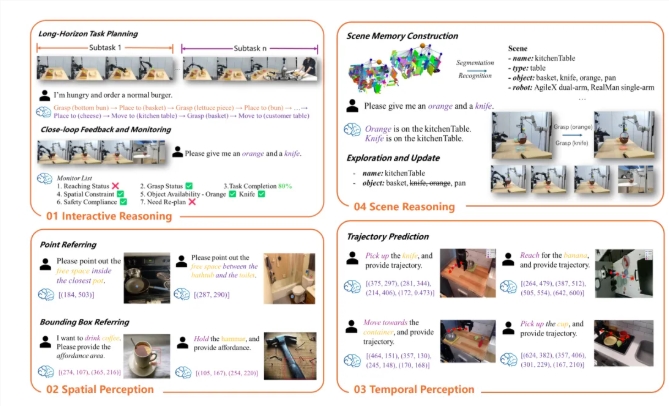Zhiyuan Institute officially released the latest achievements of the embodied intelligence system — RoboBrain2.0 32B version and the cross-ontology large and small brain collaboration framework RoboOS2.0 standalone version. RoboBrain2.0, as a "general embodied brain," combines perception, reasoning, and planning capabilities, achieving breakthrough results in multiple authoritative benchmark tests. Compared to the previous 7B version, the new version has stronger spatiotemporal cognition capabilities, enabling it to perform complex tasks in real physical environments.
Features of RoboBrain2.0 include precise spatial understanding, long-term planning, and long-chain reasoning capabilities, helping robots work efficiently in complex environments. Through a modular architecture design, RoboBrain2.0 integrates various information such as images, videos, and language instructions, supporting real-time analysis of complex scenarios.
Additionally, RoboOS2.0, as the world's first embodied intelligence SaaS open-source framework, adopts a serverless architecture, enabling lightweight deployment. This framework allows intelligent brains to collaborate efficiently with different types of robots, promoting the development of robots from "single-machine intelligence" to "group intelligence." Through the RoboSkill skill store, users can easily obtain and adapt various robot skill modules.

In terms of performance, RoboBrain2.0 significantly enhances the robot's understanding and decision-making capabilities by relying on multi-modal datasets and phased training strategies. The model repeatedly breaks records in major evaluation benchmarks, demonstrating excellent spatial and temporal reasoning abilities. Through multiple stages of training, RoboBrain2.0 not only masters basic spatial perception and time modeling but also shows outstanding reasoning abilities in complex embodied tasks.
The two new technologies from Zhiyuan Institute will further promote the application development of embodied intelligence, allowing robots to make autonomous decisions in more complex environments and improve operational efficiency.
Currently, RoboBrain2.0 and RoboOS2.0 are fully open-sourced, with all model weights, training code, and evaluation benchmarks available.
RoboBrain2.0:
GitHub: https://github.com/FlagOpen/RoboBrain2.0
Checkpoint-32B: https://huggingface.co/BAAI/RoboBrain2.0-32B
FlagRelease multi-chip image for RoboBrain2.0:
https://huggingface.co/FlagRelease/RoboBrain2.0-32B-FlagOS
RoboOS2.0:
GitHub: https://github.com/FlagOpen/RoboOS
Key points:
🌟 The 32B version of RoboBrain2.0 sets new records on multiple authoritative benchmarks, with strong spatiotemporal cognition capabilities.
🤖 RoboOS2.0 realizes cross-body collaboration, supports multi-agent collaboration, and promotes the development of group intelligence.
📊 The release of the new technology will significantly enhance the robot's understanding and decision-making capabilities in complex environments.
